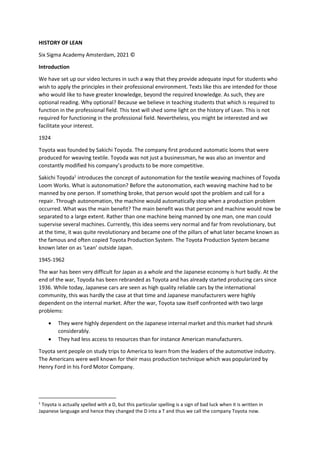
HIST OF LEAN
- 1. HISTORY OF LEAN Six Sigma Academy Amsterdam, 2021 © Introduction We have set up our video lectures in such a way that they provide adequate input for students who wish to apply the principles in their professional environment. Texts like this are intended for those who would like to have greater knowledge, beyond the required knowledge. As such, they are optional reading. Why optional? Because we believe in teaching students that which is required to function in the professional field. This text will shed some light on the history of Lean. This is not required for functioning in the professional field. Nevertheless, you might be interested and we facilitate your interest. 1924 Toyota was founded by Sakichi Toyoda. The company first produced automatic looms that were produced for weaving textile. Toyoda was not just a businessman, he was also an inventor and constantly modified his company’s products to be more competitive. Sakichi Toyoda1 introduces the concept of autonomation for the textile weaving machines of Toyoda Loom Works. What is autonomation? Before the autonomation, each weaving machine had to be manned by one person. If something broke, that person would spot the problem and call for a repair. Through autonomation, the machine would automatically stop when a production problem occurred. What was the main benefit? The main benefit was that person and machine would now be separated to a large extent. Rather than one machine being manned by one man, one man could supervise several machines. Currently, this idea seems very normal and far from revolutionary, but at the time, it was quite revolutionary and became one of the pillars of what later became known as the famous and often copied Toyota Production System. The Toyota Production System became known later on as ‘Lean’ outside Japan. 1945-1962 The war has been very difficult for Japan as a whole and the Japanese economy is hurt badly. At the end of the war, Toyoda has been rebranded as Toyota and has already started producing cars since 1936. While today, Japanese cars are seen as high quality reliable cars by the international community, this was hardly the case at that time and Japanese manufacturers were highly dependent on the internal market. After the war, Toyota saw itself confronted with two large problems: • They were highly dependent on the Japanese internal market and this market had shrunk considerably. • They had less access to resources than for instance American manufacturers. Toyota sent people on study trips to America to learn from the leaders of the automotive industry. The Americans were well known for their mass production technique which was popularized by Henry Ford in his Ford Motor Company. 1 Toyota is actually spelled with a D, but this particular spelling is a sign of bad luck when it is written in Japanese language and hence they changed the D into a T and thus we call the company Toyota now.
- 2. However, it soon became clear that Toyota could not realistically copy the American way of working. Why? The previously mentioned two constraints made that very difficult. Toyota did not have a big international market and as such could not realistically rely on mass production. Second of all, the Americans used resources very liberally. The US had some of the best access to various resources, ranging from human resources to materials. This was not the case in Japan where resources were much more scarce. As such, Toyota decided to not copy the American producers but rather create a production model for itself which would have some big contrasts with the American production model. Toyota would: • Let production be dictated by demand. This principle is called pull production and will be explained in detail during the course. • Focus on detecting and eliminating waste during the production. Please note that Toyota defined waste in a different way than we define it in our everyday language. This too will be explained in more detail during the course. • Do not view production as optimal at any point, but see it at suboptimal at any point and try to improve it on a daily basis. This was the Kaizen principle. We will explain Kaizen in detail during the course. At this point, words like Kaizen, and pull production might not really be clear for you. Do not worry, they shall be dealt with intensively during the rest of the course. But now you have a basic idea of the evolution of this Toyota Production System which became known as Lean outside Japan. 1962-present When the Toyota Production System became popular outside Japan, it became known as Lean. Lean Management and Lean Manufacturing are just offshoots of Lean, the former focusing on its applications in general management and the latter mostly focusing on its applications in a purely manufacturing context. It should be noted that our course has parts from Lean Management and Lean Manufacturing integrated in it and as such is suitable for all sectors. Lean has gone though somewhat of an evolution. Small additions have been made throughout the years to the original version which was derived from the Toyota Production System. It is important that you realize that Lean does not have an internationally agreed upon body of knowledge. Various universities, companies and training institutes have sometimes added little bits to it, removed little bits from it, or changed bits to better fit them. This is unfortunate, but it is fact that we have to just live with. However, the fact that we do not have an internationally agreed upon agreement on what Lean is, does not mean that every version is completely different. Roughly speaking, you could say that there is agreement on 80-90% of the content, whereas 10-20% of the content is different depending on the university, training institute, or company.